U.S. Department of Transportation
Federal Highway Administration
1200 New Jersey Avenue, SE
Washington, DC 20590
202-366-4000
Federal Highway Administration Research and Technology
Coordinating, Developing, and Delivering Highway Transportation Innovations
| PRESENTATION |
| This presentation is an archived publication and may contain dated technical, contact, and link information |
|
| Publication Number: N/A Date: January 2014 |
Publication Date: January 2014
|
PDF files can be viewed with the Acrobat® Reader®
Long-Term Bridge Performance Workshop
Transportation Research Board
93rd Annual Meeting
January 16, 2014
| Test procedure for concrete compressive strength | 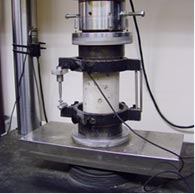 |
| ASTM C 39 Compressive Strength of Concrete |  |
Data Collected:
|
References:
|
Process description: Data collection principle: A bridge superstructure is defined as that portion of a bridge structure that receives and supports traffic loads (distributed by the bridge deck) and inturn transfers these loads to the bridge substructure:including the bridge bearings. A steel superstructure can consist of girders (single or multi-cell box): floorbeams and stringers (concrete encased, rolled, and welded or bolted plates), cross frames and diaphragms. In addition, truss structures may have built-up sections for top and bottom chords, vertical and diagonal members, and lateral and sway frame bracings. Depending on the site conditions: access to the superstructure members will involve the use ofladder(s), access platform(s) and or a snooper. Steel members shall be inspected primarily for paint peeling, pitting, corrosion (See Protocol FLD-DC-VI-0 02), section loss (See Protocol FLD- DC-VI-003): and cracking (future protocol). In particular, locations of high stress zones shall be thoroughly inspected. Also, any damages from vehicle or vessel strikes shall be noted. The bearings for the superstructure will be inspected according to the relevant protocol: FLD-DC-VI-004, FLD-DC-.V1-005, or FLD-DC-VI-006. |
Photo:
|
LTEIP Data Collection Table for Protocol FLD-DC-VI-001 |
||||||
| # | Field Name | Data Type | Format /Accuracy | Unit | Required | Field Description |
| 1 | State | Text | Text | Yes | State Code, e.g., Virginia-VA | |
| 2 | NBI Structure # | Text | Text | Yes | Item 8 -Structure Number from NBI Coding Guide | |
| 3 | Structure name | Text | Text | Yes | Descriptive name for the bridge, e.g.., Route 15 SB over 1-66 | |
| 4 | Protocol name | Text | Text | Yes | Title of the protocol | |
| 5 | Personnel performing inspection activities | Text | Text | Yes | First name(s), last name(s) | |
| 6 | Date of inspection | Text | Date/Exact date | Yes | mm/dd/ww | |
| 7 | Span number | Text . | Text | Yes | ||
| 8 | Paint peeling/ | Text | Yes / No | Yes | ||
| 9 | Pitting rust /corrosion | Text | Yes/ No | Yes | ||
| 10 | Loss of section | Text | Yes / No | Yes | ||
| 11 | Cracking | Text | Yes / No | Yes | ||
| 12 | Collision damage | Text | Yes / No | Yes | ||
| 13 | Presence of a concrete |
Text | Yes / No | Yes | ||
| 14 | Defect photos | BLOB | BLOB | Optional | If defects present, document typical defects with photos a ndlor sketches | |
| 15 | Comments | Text | Unlimited | Optional | ||
| diagram | 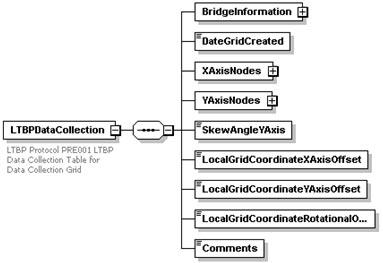 |
| namespace | https://www.fhwa.dot.gov/research/tfhrc/programs/infrastructure/structures/ltbp/ |
| properties | content complex |
| children | BridgeInformation DateGridCreated YAxisNodes SkewAngleYAxis localGridCoordinateXAxisOffset LocalGridCoordinateYAxisOffset LocalGridCoordinateRotationalOffset Comments |
| annotation | documentation LTBP Protocol PRE001 LTBP Data Collection Table for Data Collection Grid |
| source | <xs:element name="LTBPDataCollection"> <xs:annotation> <xs:documentation>LTBP Protocol PRE001 LTBP Data Collection Table for Data Collection Grid</xs:documentation> </xs:annotation> <xs:compiexType> <xs:sequence> <xs:element name="Bridgelnformation"type="bridgelnformationType"maxOccurs="1"/> <xs:element name="DateGridCreated"type="xs:date"maxOccurs="1"/> |
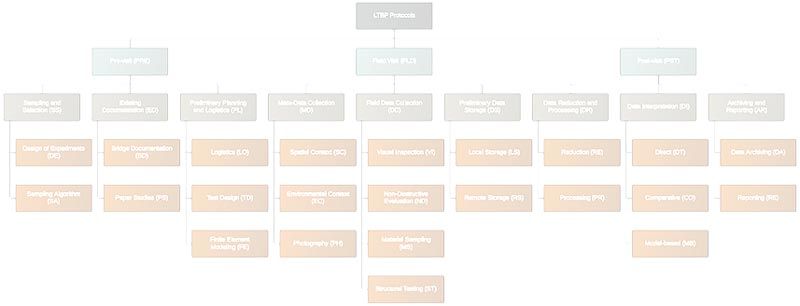
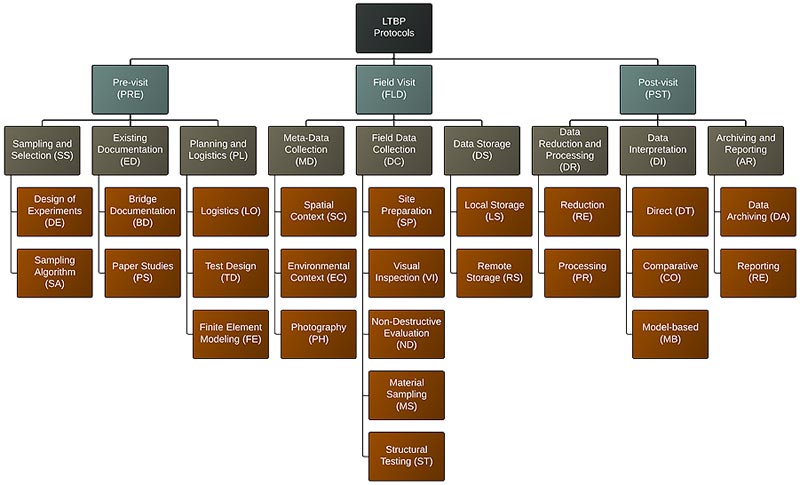
XXX-YY-ZZ-### |
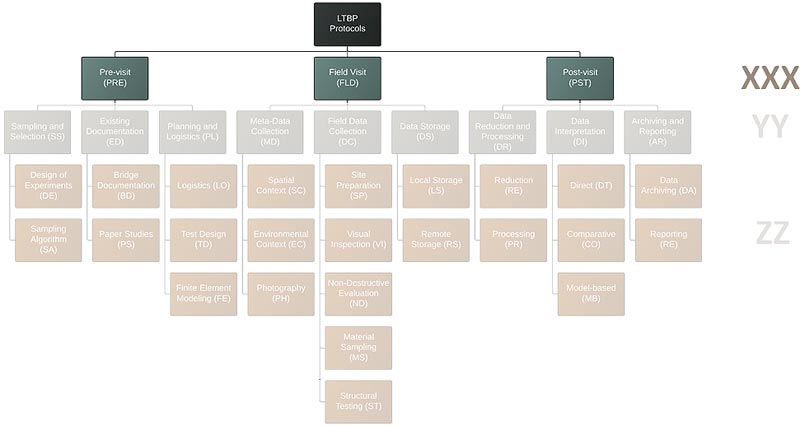
|
Stage Level |
XXX-YY-ZZ-### |
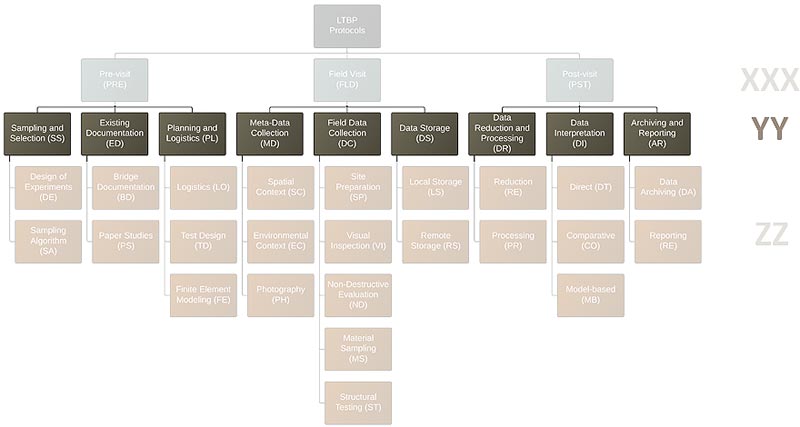
|
Category Level |
XXX-YY-ZZ-### |
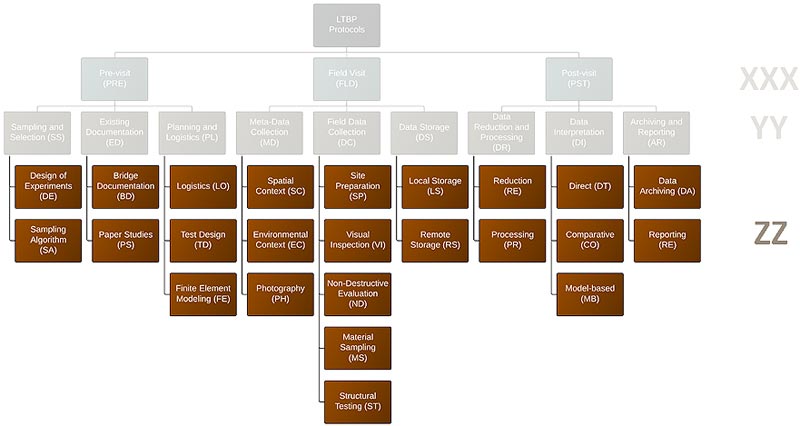
|
Application Level |
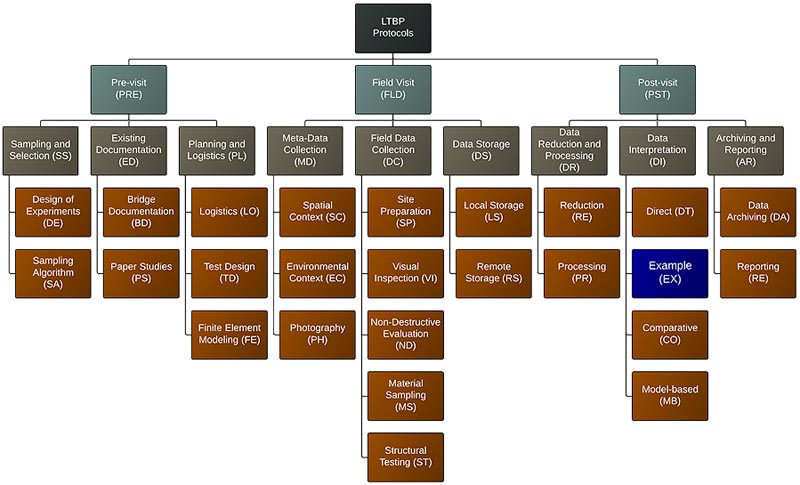
| Primary Group |
Secondary Group | Protocol Number (Tentative) |
Protocol Name | Anticipated Delivery Batch |
| PRE | ED (Existing Documentation ) |
001 | Plans and Specifications for Bridge Design and Construction | Batch #1 |
| 002 | Bridge Construction Records | |||
| 003 | Bridge Design and Construction Data | |||
| 004 | Bridge Site Conditions - Climate, Environment, Traffic | |||
| 005 | Bridge Inspection Records | |||
| 006 | Bridge Maintenance and Rehabilitation - Records and Cost Data | |||
| 007 | Calculations of Bridge Ratings | |||
| 013 | Untreated Bridge Deck Paper Study | |||
| PL (Preliminary Planning and Logistics) |
005 | Reference Bridge Testing | Batch #1 | |
| 006 | Cluster Bridge Testing | |||
| FLD | MD (Meta-Data Collection} |
001 | Data Collection Grid and Coordinate System | Batch #1 |
| 002 | Structure Segmentation and Numbering System |
| FLD | |||
| Secondary Group |
Protocol Number (Tentative) |
Protocol Name | Anticipated Delivery Batch |
| DC (Field Data Collection) |
001VI | Steel Superstructure Deterioration - General | Batch #1 |
| 002VI | Concrete - Deterioration (General) | ||
| 004VI | Substructure (General) | ||
| 005VI | Elastomeric Bearings | ||
| 006VI | Pot bearings | ||
| 007VI | Rocker Bearings | ||
| 008VI | Expansion Joints | ||
| 010VI | Steel Superstructure - Corrosion | ||
| 011VI | Steel Superstructure - Section Loss | ||
| 012VI | Concrete - Abrasion | ||
| 013VI | Concrete - Cracking | ||
| 014VI | Concrete - Spalls and Delamination | ||
| 015VI | Condition Assessment of Asphalt Overlays | ||
| 016VI | Moisture and Efflorescence | ||
| 017VI | Sulfate Attack | ||
| 018VI | Drainage/Ponding | ||
| 019VI | Chain Drag |
| FLD | Secondary Group |
Protocol Number (Tentative) |
Protocol Name | Anticipated Delivery Batch |
| DC (Field Data Collection) |
020ND | Electrical Resistivity | Batch #1 | |
| 021ND | Ground Penetrating Radar Testing | |||
| 022ND | Half Cell Potential | |||
| 023ND | Impact Echo Testing | |||
| 024ND | Linear Polarization Resistance | |||
| 025ND | Dye Penetrant Testing | |||
| 026ND | Ultrasonic Surface Wave Testing (Concrete} | |||
| 027ND | Ultrasonic Testing - Steel Fatigue Cracking | |||
| 030MS | General Concrete Sampling, Testing and Analysis Plan | |||
| 031MS | Wet Coring (Field Sampling) of concrete Decks | |||
| 032MS | Strength and Static and Dynamic Elastic Moduli of Concrete Cores | |||
| 033MS | Resistance to Chloride Penetration (Permeability) | |||
| 034MS | Sampling and Testing for Chloride Profiles |
| Primary Group |
Secondary Group | Protocol Number (Tentative) |
Protocol Name | Anticipated Delivery Batch |
| PST | DR (Data Reduction and Processing) |
001 | Spatial Correlation | Batch #3 |
| 002 | Peak Extraction | |||
| 003 | Averaging | |||
| 004 | Error Screening | |||
| DI (Data Interpretation) |
005 | Comparison of Modalities of Instrumentation | Batch #3 | |
| 006 | Spatial Interpretation | |||
| 007 | Time Comparison | |||
| 008 | Structure Comparison | |||
| 009 | Cluster Comparison | |||
| 010 | Global Finite Element Modeling | |||
| 011 | Detailed Finite Element Modeling | |||
| 012 | Model-Experiment Correlation | |||
| 013 | Scenario Analysis |
| Batch # | Status |
| 1 | In final stages of review for publication in an FHWA report: Long Term Bridge Performance Program: Inspection Protocols, Version1 |
| 2 | 2014 |
| 3 | Early 2015 |